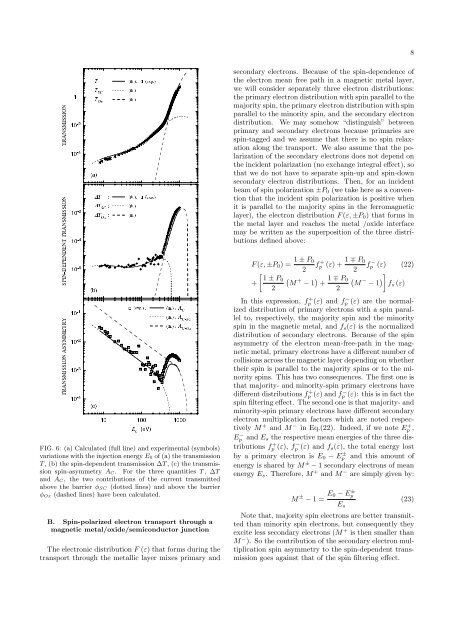Etudes par microscopie en champ proche des phénomènes de ...
Etudes par microscopie en champ proche des phénomènes de ...
Etudes par microscopie en champ proche des phénomènes de ...
You also want an ePaper? Increase the reach of your titles
YUMPU automatically turns print PDFs into web optimized ePapers that Google loves.
secondary electrons. Because of the spin-<strong>de</strong>p<strong>en</strong>d<strong>en</strong>ce ofthe electron mean free path in a magnetic metal layer,we will consi<strong>de</strong>r se<strong>par</strong>ately three electron distributions:the primary electron distribution with spin <strong>par</strong>allel to themajority spin, the primary electron distribution with spin<strong>par</strong>allel to the minority spin, and the secondary electrondistribution. We may somehow “distinguish” betwe<strong>en</strong>primary and secondary electrons because primaries arespin-tagged and we assume that there is no spin relaxationalong the transport. We also assume that the polarizationof the secondary electrons does not <strong>de</strong>p<strong>en</strong>d onthe incid<strong>en</strong>t polarization (no exchange integral effect), sothat we do not have to se<strong>par</strong>ate spin-up and spin-downsecondary electron distributions. Th<strong>en</strong>, for an incid<strong>en</strong>tbeam of spin polarization ±P 0 (wetakehereasaconv<strong>en</strong>tionthat the incid<strong>en</strong>t spin polarization is positive wh<strong>en</strong>it is <strong>par</strong>allel to the majority spins in the ferromagneticlayer), the electron distribution F (ε, ±P 0 )thatformsinthe metal layer and reaches the metal /oxi<strong>de</strong> interfacemay be writt<strong>en</strong> as the superposition of the three distributions<strong>de</strong>fined above:8FIG. 6: (a) Calculated (full line) and experim<strong>en</strong>tal (symbols)variations with the injection <strong>en</strong>ergy E 0 of (a) the transmissionT , (b) the spin-<strong>de</strong>p<strong>en</strong>d<strong>en</strong>t transmission ΔT , (c) the transmissionspin-asymmetry A C. For the three quantities T , ΔTand A C, the two contributions of the curr<strong>en</strong>t transmittedabove the barrier φ SC (dotted lines) and above the barrierφ Ox (dashed lines) have be<strong>en</strong> calculated.B. Spin-polarized electron transport through amagnetic metal/oxi<strong>de</strong>/semiconductor junctionThe electronic distribution F (ε) that forms during thetransport through the metallic layer mixes primary andF (ε, ±P 0 )= 1 ± P 0f p + (ε)+ 1 ∓ P 0fp − (ε) (22)[221 ± P0 (+ M + − 1 ) + 1 ∓ P 0(M − − 1 )] f s (ε)22In this expression, f p + (ε) andfp − (ε) areth<strong>en</strong>ormalizeddistribution of primary electrons with a spin <strong>par</strong>allelto, respectively, the majority spin and the minorityspin in the magnetic metal, and f s (ε) is the normalizeddistribution of secondary electrons. Because of the spinasymmetry of the electron mean-free-path in the magneticmetal, primary electrons have a differ<strong>en</strong>t number ofcollisions across the magnetic layer <strong>de</strong>p<strong>en</strong>ding on whethertheir spin is <strong>par</strong>allel to the majority spins or to the minorityspins. This has two consequ<strong>en</strong>ces. The first one isthat majority- and minority-spin primary electrons havediffer<strong>en</strong>t distributions f p + (ε) andfp − (ε): this is in fact thespin filtering effect. The second one is that majority- andminority-spin primary electrons have differ<strong>en</strong>t secondaryelectron multiplication factors which are noted respectivelyM + and M − in Eq.(22). In<strong>de</strong>ed, if we note E p + ,Ep− and E s the respective mean <strong>en</strong>ergies of the three distributionsf p + (ε), fp − (ε) andf s (ε), the total <strong>en</strong>ergy lostby a primary electron is E 0 − E p± and this amount of<strong>en</strong>ergy is shared by M ± − 1 secondary electrons of mean<strong>en</strong>ergy E s . Therefore, M + and M − are simply giv<strong>en</strong> by:M ± − 1= E 0 − E p± (23)E sNote that, majority spin electrons are better transmittedthan minority spin electrons, but consequ<strong>en</strong>tly theyexcite less secondary electrons (M + is th<strong>en</strong> smaller thanM − ). So the contribution of the secondary electron multiplicationspin asymmetry to the spin-<strong>de</strong>p<strong>en</strong>d<strong>en</strong>t transmissiongoes against that of the spin filtering effect.










![[Diffusion-Limited Aggregation - A Model for Pattern Formation].](https://img.yumpu.com/52395246/1/190x245/diffusion-limited-aggregation-a-model-for-pattern-formation.jpg?quality=85)





